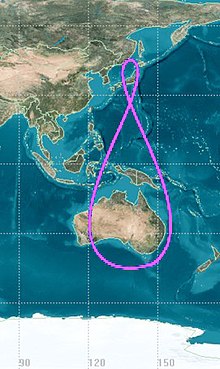Quasi-zenith satellite system
The quasi-zenith satellite system (QZSS) is a Japanese satellite system that is currently being set up , which is intended to supplement existing global navigation satellite systems (GNSS) , especially GPS . The satellite constellation of originally three geosynchronous satellites was specially designed for Japan, but other Asia-Pacific regions will also benefit from it. The system comprises four satellites (as of 2020).
Working principle
The QZSS satellites orbit the earth in a geosynchronous orbit with an orbital time of one sidereal day and an orbit height between 32,000 km and 40,000 km. The orbit inclination will be 43 °, so that at any time one of the satellites is directly over Japan (quasi in the zenith ). This increases the probability, especially in cities and in mountainous terrain, that a position determination is possible together with the satellites of the other GNSS and that the additional information sent by the QZ satellites can be received.
The QZSS has a similar structure to the other GNSS and consists of the room segment , a control segment (master control station and several observation stations ) and the user segment (the receivers).
The space segment will be equipped with GPS- complementary and experimental equipment and send equivalent signals to modern GPS. This is intended to ensure compatibility and interoperability between the systems. QZ satellites send the existing L1-C / A and L2-C-GPS signals, the future L5 and L1-C-GPS signals as well as an experimental signal with a higher data rate called LEX, which is on the same frequency as the Galileo - E6 signal is sent out. In addition, another L1-C / A signal called QZS-L1-SAIF is sent out, which is compatible with the signals of the existing SBAS . SAIF stands for "Submeter-class Augmentation with Integrity Function". This signal contains additional information about the integrity of the GPS signals and correction data to increase the accuracy of the GPS system.
development
The quasi-zenith satellite system is a joint project of public institutions and private companies ( Public Private Partnership ). From the government, four state ministries lead the investigation and development of the technology, in the private sector the business planning of commercial use (profit plan) and the construction and financing of a radio and communication system take place. The Japanese space agency JAXA is integrating research institutes into the development process.
The system is being set up in stages in accordance with the government decree of March 31, 2006. In August 2008, the system design review (Critical Design Review) was completed, so that the first QZS-1 satellite could be produced and tested.
Satellites
The launch of the first QZ satellite called Michibiki ( み ち び き , "guidance, guidance") took place on September 11, 2010 from the Tanegashima Space Center with an H-IIA F-18 launcher. The satellite weighs around 4 t and is 2.9 m long, 3.1 m wide and 6.2 m high. The two solar cell booms together have a span of 25.3 m. The second Michibiki satellite ( み ち び き 2 号 機 ) was launched on June 1, 2017, also with an H-IIA launcher. The third satellite was launched on August 19, 2017 and the fourth on October 10, 2017. Both started with additional H-IIA launch vehicles.
Web links
- JAXA: Quasi-Zenith Satellite-1 "MICHIBIKI" (English)
- Satellite Positioning Research and Application Center: Service Status of QZSS ( Memento from February 19, 2012 in the Internet Archive ) (PDF; 8.4 MB; 25 pages; December 2008; English)
Individual evidence
- ↑ JAXA | Quasi-Zenith Satellite-1 "MICHIBIKI". Retrieved on August 24, 2020 .
- ↑ New Launch Day of the First Quasi-Zenith Satellite 'MICHIBIKI' by H-IIA Launch Vehicle No. 18. JAXA, August 4, 2010, accessed August 4, 2010 .
- ↑ Successful Launch of H-IIA Launch Vehicle No. 34 Encapsulating MICHIBIKI No. 2. JAXA, June 1, 2017, accessed June 1, 2017 .
- ↑ Japan sends satellite into space for its own GPS system: [1] - Accessed June 1, 2017 - heise.de - Online
- ↑ Successful Launch, H-IIA Launch Vehicle No. 35 Encapsulating MICHIBIKI No. 3. JAXA, August 19, 2017, accessed on October 10, 2017 .
- ↑ Successful Launch, H-IIA Launch Vehicle No. 36 Encapsulating MICHIBIKI No. 4. JAXA, October 10, 2017, accessed on October 10, 2017 .
